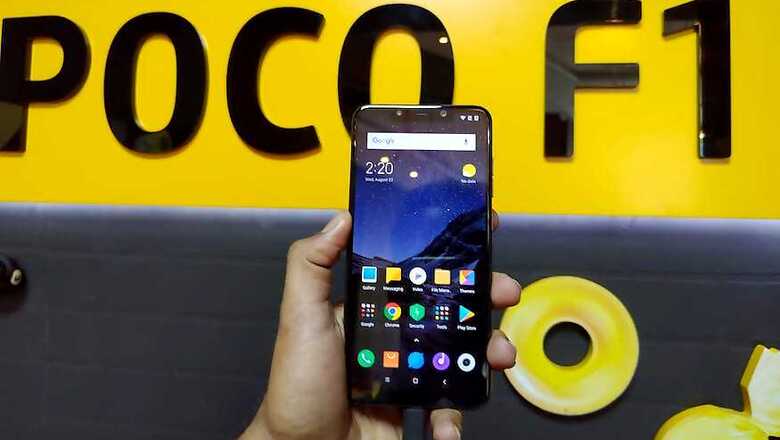
views
If you are looking to purchase a new mobile under Rs 20,000, there are some great devices in this price bracket that not only provide an impressive set of specifications but also remarkable value-for-money. This space is crowded with models with varied specifications and choosing the right one can be difficult for a buyer, but which one to buy? To make things simple, here is our list of the top 5 smartphones under 20000.
Nokia 7.1:
The Nokia 7.1 sports a 5.84-inch full HD+ display with PureDisplay screen technology for HDR10 quality experience. It has a notch on top of display and a screen aspect ratio of 19:9. The device is powered by Qualcomm’s Octa-Core Snapdragon 636 processor paired with Adreno 509 GPU and includes 4GB of RAM with 64GB internal storage, expandable memory up to 400GB via microSD. While the Nokia 7.1 runs Android 8.1 Oreo out of the box, it is upgradable to Android 9.0 (Pie).
In terms of optics, the smartphone houses a 12-megapixel (RGB) primary rear camera with f/1.8 aperture,1.28 um pixel size, dual LED flash, ZEISS optics and a 5-megapixel (Monochrome) secondary rear sensor with f/2.4 aperture and 1.12um pixel size. At the front, there is an 8-megapixel AI enhanced camera with f/2.0 aperture, 84-degree FOV, and facial recognition.
Here is a 3,060mAh non-removable battery under the hood with 18W fast charging. Connectivity options on the Nokia 7.1 include 4G LTE, Wi-Fi 802.11ac, Bluetooth v5.0, GPS/ A-GPS, GLONASS, NFC, USB Type-C, and a 3.5mm headphone jack.
Huawei Y9 (2019):
Huawei Y9 (2019) features dual camera, both on the front and rear, and supports Artificial Intelligence (AI) intelligent scenario identification and optimisation. The phone is equipped with 16MP+2MP front dual camera and 13MP+2MP rear dual sensors. Huawei Y9 (2019) features a notched FullView Display, thus, offering a higher screen to body ratio.
The 16.7-million colour IPS LCD with a contrast ratio of 1500:1 also supports "Eye Comfort Mode". The smartphone is equipped with a 4,000mAh big battery and Huawei's homegrown 12-nm Kirin 710 chipset for power efficiency. It also supports power consumption optimisation for comprehensive energy-saving technology, with one-touch battery optimisation and suspension to inactive programmes to improve standby time to several days, the company claimed.
Realme 2 Pro:
Realme 2 Pro sports a 6.3-inch (1080x2340 pixels) full-HD+ screen with 90.8 percent screen-to-body ratio, 19.5:9 aspect ratio, and 409ppi pixel density. The device is powered by Qualcomm’s octa-core, AI-enabled, Snapdragon 660 AIE SoC, which allows better performance and runs on Android 8.1-based ColorOS. This is paired with three memory options of 4GB, 6GB and 8GB along with two storage options of 64GB and 128GB.
The Realme 2 Pro sports a 16-megapixel + 2-megapixel dual-camera setup at the back, with the second sensor enabling depth-effect shots. At the front, there is a 16-megapixel camera, which is also capable of portrait shots through an AI-based depth effect. The phone has 3,500 mAh battery capacity but lacks support for fast charging.
Asus ZenFone Max Pro M2:
The dual-SIM (Nano) Asus ZenFone Max Pro M2 (ZB630KL) runs stock Android 8.1 Oreo, and sports a 6.26-inch full-HD+ (1080x2280 pixels) with an 19:9 aspect ratio. The smartphone is powered by a Qualcomm Snapdragon 660 SoC, coupled with 3GB, 4GB, or 6GB of LPDDR4x RAM depending on the variant. There is either 32GB or 64GB of inbuilt storage on the Asus ZenFone Max Pro M2, depending on the model purchased, expandable via microSD card (up to 2TB) with its own dedicated slot.
The Asus ZenFone Max Pro M2 sports a dual rear camera setup, with a 12-megapixel primary sensor (Sony IMX486 sensor, f/1.8 aperture, and 1.25-micron pixels) coupled with a 5-megapixel dedicated depth sensor. The rear setup features EIS, 4K video recording support, and an LED flash module. On the front, the ZenFone Max Pro M2 sports a 13-megapixel sensor with an f/2.0 aperture, 1.12-micron pixels, and an LED flash module. Connectivity options on the smartphone include dual 4G VoLTE, Wi-Fi 802.11 b/g/n, Bluetooth v5.0, GPS/ A-GPS, FM radio, a 3.5mm headphone jack, and a Micro-USB port.
Xiaomi Poco F1:
The Poco F1 comes with pretty impressive firepower under the hood for its price. For starters, the device is powered by Qualcomm Snapdragon 845 processor with AI prowess in the form of AIE 845. As per the company, the Poco F1 uses a LiquidCool technology that allows a better thermal performance than most of its rivals. As for the memory onboard, the smartphone offers 6GB/ 8GB RAM and 64GB/ 128GB/ 256GB of internal storage across its variants. There is also an expandable memory of up to an additional 256GB using an external microSD.
As for its optics, the Poco F1 houses a 12-megapixel + 5-megapixel dual camera setup at the back with AI enhancements and Dual Pixel Autofocus. There is a 20-megapixel selfie shooter at the front with AI Beautify. The device runs a new version of Xiaomi’s own MIUI which is specially designed for Poco. The company has also promised the arrival of Android P on the smartphone within the Quarter 4 of 2018. Poco F1 is backed by a massive 4000 mAh battery that also supports Quick Charge 3.0 and a USB Type-C connectivity.




















Comments
0 comment